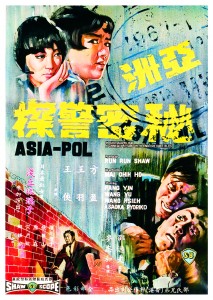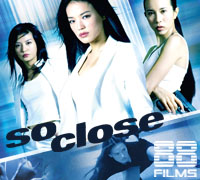AKA: Asiapol
Director: Ma Chi Ho
Writer: Gan Yamazaki
Producer: Kenzo Asada, Run Run Shaw
Cast: Jimmy Wang Yu, Ryoriko Asaoka, Wong Hap, Cheung Pooi Saan, Yuen Sam, Jo Shishido, Takashina Kaku, Chan Sing, Gam Tin Chue
Running Time: 97 min.
By Matthew Le-feuvre
When Sean Connery announced of his unexpected departure from the James Bond franchise in early ’67, and that You Only Live Twice would be his final entry, disbelief shook the film world. Financiers, investors and fans of Ian Fleming’s popular literary creation fretted, pondered, and even obsessed what direction Britain’s superspy was to recommence from. Understandable, Connery – at this point – had become totally disenchanted with not only the legalities of his contract, but furthermore his artistic constrictions as an actor; despite the fact (away from Bond) he’d sucessfully garnered lead roles in Hitchcock’s psychological thriller Marnie (1964) and the brutal stockade drama The Hill (1965).
Although former model/TV advert star, George Lazenby, had been furtively engaged too replace, even supersede, Connery before eventually sucumbing to the igmony of Albert Broccoli and Harry Saltzman’s alleged “black listing” tactics, numerous powerful studios – including the Shaw Brothers – regarded Connery’s temporary absence (he subsequently returned to the role in 1971 for Diamonds Are Forever and unofficially in 1983 for Never Say Never Again) as as an opportunity to muscle in on the proceedings with their own variations, interpretations and debatable cash-ins: The Man From Uncle (1964-68) and Our Man Flint/In Like Flint (1965/67). Surprisingly, even Connery’s own younger sibling, Neil, starred in Operation Kid Brother (1968), a forgettable slice of hokum, which included the exploitation of the original Bond-essemble (Lois Maxwell, Bernard Lee, etc.) to audaciously re-casting Anthony Dawson and Adolpho Celi in similar antagonist roles as presented under Terence Young’s direction for Dr No (1962) and Thunderball (1965) respectively.
While George Lazenby was being conditioned, groomed and moulded into 007, albeit one-time only; fresh from his groundbreaking performance as the mono-limbed Feng, Jimmy Wang Yu briefly traded in his half-sword for gadgetry of an alternative kind as the modern world of espionage is transported from the gritty industrialism of Japan to the obstreperous back streets, and costal ports of both Hong Kong and Macao. However budget-wise Asiapol fails dramatically from the outset to capture or take advantage of the exotic splendors on offer, unlike its international counterpart You Only Live Twice (also ’67).
Clocking in at just 92 minutes, Asiapol explosively begins with top agent, Chen Ming Xuan (Wang Yu) trailing a gold smuggling organization – headed by a shady character singularly known as ‘George’ – who he suspects are concealing their loads in transport trucks. In a dizzy sequence virtually lifted from the finale of From Russia With Love (1963), a helicopter aerial attack leaves Ming Xuan’s partner, Chen Loong-Seng, fatally wounded while Ming himself narrowly escapes a falling barrage of hand grenades. From there on the potentiality of much eye-brow raising is sadly dampened by obvious femme-fatales, protracted foot pursuits, as well as an obligatory-wining air hostess with a secret – all await Ming as he meanders from one encounter to another avoiding incendiary golf balls (of all things!), a novelty in-car bomb made all too apparent by a “tick-tock” acoustics and an enigmatic assassin named Lai Yu-Tien (Wang Hsia), whose actions appear contradictory on both sides.
It goes without saying that despite these standard plot elements or budgetary reasons for downplaying travelogue landscapes/production values. Rough fistfights are few and far between Ming’s less-than-tense confrontation with nemesis ‘George’ – revealing a trite, almost immature confessional; and a strained ‘would-be’ relationship with Monneypenny-type contact, Miss Sachiko (Ryoriko Asaoka), is repeatedly marred by stale dialogue in addition too tiresome interactions devised in (either) a telephone box, melancholic bars or claustrophobic hotel rooms: yet, all are favourable for expeditious departures.
Verdict: Not in the usual Wang Yu cannon, having begun his career mostly in traditional features. However, over the years Asiapol has been critically deemed as one of the Shaws’ more obscure co-productions (in association with Nikkatsu Films, Japan), eventhough genre-wise, they’d previously bank rolled independent spy thrillers: Operation Macao (1966) and the rather libel James Bond Chinese Style (1967) with varying degrees of commerciality. As for this picture, structurally, Asiapol is (A): disappointingly episodic; (B): convoluted script-wise to being (C): utterly banal. Indeed a little humour would’ve sufficed! Nevertheless, whether or not (?) Wang Yu was conciously aware of these shortcomings, unarguably he returned on better form – not just in physical terms – for Golden Harvest’s vastly superior The Man From Hong Kong (1974).
Matthew Le-feuvre’s Rating: 5/10





As a fan of both Shaw Brothers movies and Nikkatsu yakuza flicks, the fact that there’s not a single mention of Joe Shishido as the villain, is the equivalent of reviewing ‘You Only Live Twice’ and omitting to mention Donald Pleasence’s role as Blofeld…it’s a crime! For the very novelty of watching the Shaw Brothers bad boy take on Nikkatsu’s go-to yakuza star of the era, ‘Asia-pol’ warrants a watch. Shishido, who starred in several of Seijin Suzuki’s seminal works, from ‘Youth of the Beast’ to ‘Branded to Kill’ (made the same year), had a very distinctive look, which was down to cheek implants that he believed made him look more handsome! However I do agree that it’s best viewed as more of a Nikkatsu style production than a Shaw Brothers effort, both in style and tone, and this is no doubt partly due to it being directed by Matsuo Akinori (the start of this review states the director is Ma Chi Ho, which is the Chinese name for Akinori).
So while many people will state the greatest HK/Japan crossover was Wang Yu taking on Shintaro Katsu as Zatoichi, in ‘Zatoichi Meets the One Armed Swordsman’….the face off between two legends at the height of their careers in ‘Asia-pol’ makes it a worthy second.
It’s worth noting that just like the Zatoichi crossover is rumored to have an alternative ending for Chinese audiences, due to ‘Asia-pol’ being co-financed by Nikkatsu, an almost shot-for-shot version was filmed for Japanese audiences. Same director, same cast, same story, same locations….just with Japanese actor Nitani Hideaki in Jimmy Wang Yu’s role. Definitely a curiosity for those willing to track it down.
I never could find if there was actually a Hong Kong ending for Zatoichi Meets the One-Armed Swordsman. Rumors of course, but not exact information. It seems weird that I haven’t been able to get an exact answer on this (which then tends me to believe it is rumored only, or it was considered but never filmed or it was deleted.)
Joe Shishido is something else. But then he is addicted to rice (in joke.) For some reason he thought looking more chipmunk like would make him stand out. I do tend to enjoy his acting and personality.
Shaw Brothers certainly had a bunch of spy films or related themes in the mid 60s. While I have not seen this one, ones like Summons to Death (1967) come to mind. You could not only see the Bond and Flint references (mentioned in the review), but also Matt Helm as well.
While I don’t know which company put more money in it, I’d certainly consider this primarily a Japanese film. Nikkatsu had been churning out stylized action films like this for years, and most of the filmmakers here were Nikkatsu employees. The Japanese version with Nitani in the lead also came out already in 1966 while the HK version wasn’t released until 1967.
The Japanese version has the advantage of featuring the original voices for most of the cast (Shishido, Asaoka, and of course Nitani); nevertheless, I do prefer Wang Yu’s youthful charisma over Nitani’s performance. Otherwise the two versions are almost identical as far as I could tell with both actors doing the exact same poses.
It’s also worth noting that many of the spy films Shaw Bros produced later in the 60s (e.g. The Black Falcon and Inter-Pol) were directed by Japanese Nikkatsu directors.
Hmmm in the original Chinese poster, Jo Shishido isn’t even credited! (unless there’s an alias there somewhere?)
His name seems to be there in hanzi/kanji (宍戸錠), just not written in English. See directly above the “W” in the Shaw Scope logo. I can’t see the last character well enough to tell if it’s the same or not, though.
That being said, I believe it was a pretty common practice to use Chinese fake names for Japanese filmmakers. Shaw Brothers very much appreciated the Japanese talent, and quite often used Japanese directors, cinematographers etc. but didn’t seem to be so confident the audience would agree. Hence, Japanese filmmakers were often given a Chinese name in the credits. Here also, you can see the director Akinori Matsuo is credited as Mai Chih Ho.
Impressive. You’re like the Sherlock Holmes of this stuff.